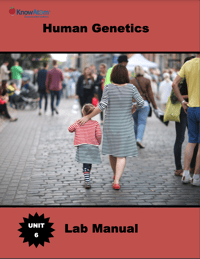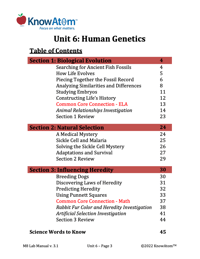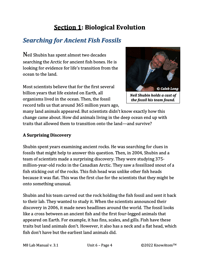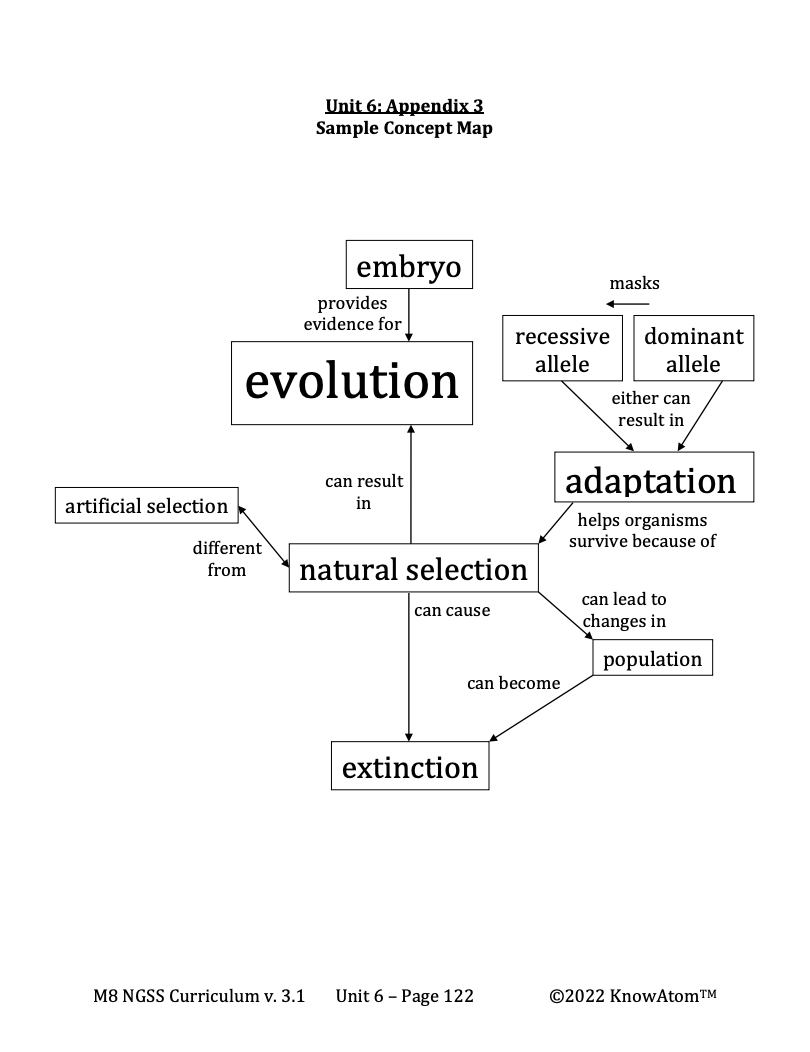Students apply their knowledge of life and heredity to the theory of evolution, exploring how the fossil record, DNA analysis, and embryonic comparisons provide evidence of common ancestry and diversity.
In this unit, students figure out connections between genes and heredity to evolution, focusing on figuring out the phenomena of how both genetic information and the environment influence how a population develops over time. In this lesson, students apply their knowledge of life and heredity to the theory of evolution, exploring how the fossil record, DNA analysis, and embryonic comparisons provide evidence of common ancestry and diversity. This page is a high-level extract of this lesson.
The science background section provides teachers with more in-depth information on the phenomena students explore in this unit on animal diversity.
It’s important to take a moment to define theory in the scientific context. When scientists refer to a theory such as the theory of evolution, they are referring to an explanation about the natural world that is supported by numerous data and has been repeatedly tested and confirmed. In this sense then, evolution is widely agreed upon within the scientific community, even though it remains controversial among some religious communities.
Here we are presenting some of the scientific evidence that supports evolution. Much of the scientific evidence for evolution comes from the fossil record, which includes all of the fossils that have ever been found on Earth. Fossil hunters like Shubin look for fossils that can tell us about the evolutionary changes that have led to the many millions of species on Earth today. They know that the best place to find fossils is often in sedimentary rock because of how sedimentary rock is formed.
As layers of sand, soil, clay, gravel, and other sediment build up in one location over time, the pressure of the layers eventually compacts the sediment into sedimentary rock. The remains of living things can become trapped in the layers of rock that build up over time. Over millions of years, heat and pressure turned these remains into fossils. Because of how they are formed, the fossils in lower layers of rock are older than fossils in higher layers.
There are different ways that scientists can determine the age of a rock or fossil. Using the layers of a rock sample can help geologists determine the relative age of different rocks and fossils, which tells scientists whether something is younger or older than something else. It is not a specific age of something. Numeric age is a precise number (in years, minutes, or other unit of time) that represents how much time has passed. For example, Earth is 4.6 billion years old. This is a numeric age, not a relative age. Scientists use a method called radiometric dating to determine the numeric age of a rock or fossil. This method is very complicated, but essentially it measures the radioactive decay of different elements within a rock or fossil to measure its numeric age.
Even though specific details may change based on new findings, scientists generally agree on the broad evolutionary timeline. This is in part because scientists use more than just anatomical similarities among fossils to support the theory of evolution. DNA analysis is another tool that scientists can use. For example, we know that all living things are made of cells and have their genetic information stored in molecules of DNA. This is true for the most ancient life form and for modern-day humans, and every life form in between.
There are levels of similarities and differences between the DNA of different organisms. Let’s begin with individual organisms. We know that every living thing has a unique sequence of nucleotides, and it is that unique sequence that makes each individual different from all other organisms. For example, the exact sequence of your DNA is unique to you—no one else has the exact identical DNA sequence.
But all organisms within a species have very similar DNA. A species is a group of genetically similar organisms. For example, humans are a species, as are lions and walruses. All people have 99.9 percent of their genetic makeup in common. This means that all of the differences among all of the people in the world come from just 0.1 percent of our DNA.
When scientists have compared the DNA of humans with the DNA of chimpanzees, they have found that people and chimps share 99 percent of their DNA. The 1 percent that is different accounts for all of the differences between chimpanzees and people. Scientists use these analyses of DNA to infer evolutionary relationships.
The similarities among DNA tell scientists that humans and chimps are very closely related. Scientists believe that humans and chimps descended from a common ancestor beginning around 12-13 million years ago. It’s important to note here that this doesn’t mean that scientists believe humans are descended from chimps. This is a common misconception about how evolution works.
Essentially, scientists believe that between 12 and 13 million years ago, there was one species of organisms that over time evolved separately to form two new species: chimpanzees and humans. Each species developed a unique set of traits that allowed it to survive in its environment. We’ll explore the mechanism of how this might have occurred a little later.
Students apply their knowledge of life and heredity to the theory of evolution, exploring how the fossil record, DNA analysis, and embryonic comparisons provide evidence of common ancestry and diversity.

Prepared hands-on materials, full year grade-specific curriculum, and personalized live professional development designed to support mastery of current state science standards.
Misconception: Dominant traits are the most common traits in a population.
Fact: Whether a gene is dominant or recessive has no bearing on how common it is in a population. Instead, a dominant trait will be expressed over a recessive trait.
Embryo : the early stages of many developing multicellular organisms
Evolution : changes in the heritable traits of a population of organisms as successive generations replace one another; populations of organisms evolve, not individual organisms
Extinction : when there are no longer any living members of a species in existence
Population : all the members of a species within a particular area

Searching for Ancient Fish Fossils
Neil Shubin has spent almost two decades searching the Arctic for ancient fish bones. He is looking for evidence for life’s transition from the ocean to the land.
Most scientists believe that for the first several billion years that life existed on Earth, all organisms lived in the ocean. Then, the fossil record tells us that around 365 million years ago, many land animals appeared. But scientists didn’t know exactly how this change came about. How did animals living in the deep ocean end up with traits that allowed them to transition onto the land—and survive?
A Surprising Discovery
Shubin spent years examining ancient rocks. He was searching for clues in fossils that might help to answer this question. Then, in 2004, Shubin and a team of scientists made a surprising discovery. They were studying 375- million-year-old rocks in the Canadian Arctic. They saw a fossilized snout of a fish sticking out of the rocks. This fish head was unlike other fish heads because it was flat. This was the first clue for the scientists that they might be onto something unusual.
Shubin and his team carved out the rock holding the fish fossil and sent it back to their lab. They wanted to study it. When the scientists announced their discovery in 2006, it made news headlines around the world. The fossil looks like a cross between an ancient fish and the first four-legged animals that appeared on Earth. For example, it has fins, scales, and gills. Fish have these traits but land animals don’t. However, it also has a neck and a flat head, which fish don’t have but the earliest land animals did.


How Life Evolves
The fossil discovery by Shubin’s team has provided scientists with evidence for how millions of years ago, ocean-dwelling creatures evolved into animals that could survive on land. Evolution is the theory that describes the changes in the heritable traits of a population of organisms as successive generations replace one another. Remember that traits are physical or behavioral characteristics of an organism.
Broadly speaking, the theory of evolution says that all life on Earth descended from a common ancestor. As the earliest life forms reproduced and passed along their genetic information stored in DNA to their offspring, genetic variation appeared. This variation was first caused by mutations (permanent changes to an individual’s DNA). It was later caused by sexual reproduction and the exchange of genetic information between different populations. A population is all the members of a species within a particular area.
This genetic variation meant that some individuals had traits that were better suited to their environment than others. Those individuals were more likely to survive and pass along their traits to offspring. We’ll explore this concept in more detail in the next section.
Over the billions of years since life first appeared on Earth, scientists believe that evolution has caused all of the diversity of life forms around us today. Over many generations, different kinds of organisms evolved, each with a unique set of traits that help it survive in its environment.
Studying Arctic Rocks
Shubin’s team focused on a region in the Canadian Arctic that had rocks roughly 375 million years old. They focused on this region because they wanted to find evidence of the first animals that had transitioned from the water to the land. They already had fossil evidence showing that by 365 million years ago, there were many different kinds of land animals including ancient amphibians and reptiles. So they were looking for fossils from a time period before that.
They also wanted to find rocks that were formed in bodies of water such as oceans, lakes, or streams. This is because they knew that an animal that transitioned from the water to the land would have spent at least some time in a body of water. This would make these rocks more likely to hold fossils of this animal.
Constructing Life’s History
Scientists can use these different pieces of evidence to help piece together the story of life’s evolution. Each piece of evidence tells a different part of the story. Together, scientists can construct a timeline for how life has evolved over time.
For example, fossils can tell scientists about similarities and differences in the structures of ancient organisms. They can also tell of past environmental changes. This includes times in Earth’s history when oceans covered much of the land, and then the oceans dried up, leaving behind rocks and fossils to tell of those changes. Some of the evidence tells us that only a very small number are still alive today. Many organisms that once lived are now extinct. Extinction occurs when there are no longer any living members of a species in existence.
Whales tell an interesting story of evolution. Whales live in the ocean, but they aren’t fish. Whales are mammals, just like people. Being a mammal means they breathe air, they are warm-blooded, they give birth to live young, and they nurse their babies with milk.
Scientists believe that around 55 million years ago, there was so much food in the water that a group of land mammals began spending more time in the water. Over millions of years, this group evolved into modern whales, which live entirely in the ocean. Scientists use various pieces of evidence to support this theory of how the whale evolved. Evidence includes the fact that whale embryos have hind legs and the DNA of whales is very similar to the DNA of other mammals. Scientists have also found multiple fossils that show how the structures of the animals have evolved over time to become ocean-dwelling mammals.
For the main hands-on activity in this lesson, students design investigations where they analyze similarities in the anatomies of modern and fossil organisms, embryo development, and DNA patterns among various species to figure out evolutionary relationships. Students conduct these investigations to figure out how different species are related to one another because of evolution.
KnowAtom incorporates formative and summative assessments designed to make students thinking visible for deeper student-centered learning.

Standards citation: NGSS Lead States. 2013. Next Generation Science Standards: For States, By States. Washington, DC: The National Academies Press. Neither WestEd nor the lead states and partners that developed the Next Generation Science Standards were involved in the production of this product, and do not endorse it.
